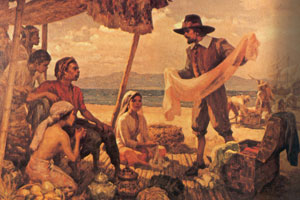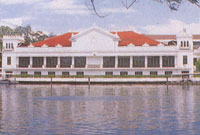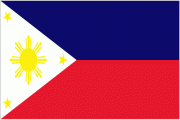
Location
The Philippines is located in Southeast Asia, on the eastern rim of the Asiatic Mediterranean. It is bounded in the west by the South China Sea; in the east by the Pacific Ocean; in the south by the Sulu and Celebes Seas; and in the north by the Bashi Channel. Its capital and main port of entry is Manila. Cebu, which is some 562 kilometers to the south of Manila, is the second largest international gateway to the country.
|
H) |
Land Area
The Philippines is an archipelago consisting of 7,100 islands with a total land area of approximately 300,000 square kilometers. It has three major island groups-Luzon in the north, Visayas in the middle and Mindanao further down in the South.
Population
The current population of the Philippines is about 80 million people. Filipinos are basically of Indo-Malay racial stock, mixed with some Chinese and Spanish ancestry.
Climate
The country has a tropical climate with two distinct seasons-wet and dry.
|
|
Language
The national language is Filipino, which is based on the language of Tagalog, although there are at least one or two dialects spoken in every region. There are more than 87 languages and dialects in the country. English is considered an official language as it is both spoken and understood throughout the Philippines and used in business, government and schools.
Religion
More than 80% of the population is Roman Catholic. Other major religions include Muslim and Protestant.
Literacy
The literacy rate in the country is 92.6%
Monetary Unit
The unit of currency is the Philippine peso. The rate of the peso to the US dollar has been fluctuating between P50-P54 to the US dollar.
Brief History of the Philippines
Early History
Historians believe the Philippines dates back to the Paleolithic age. Based on the archaeological artifacts recovered, Filipino society and culture were fairly developed prior to contacts with other countries.
Filipinos had commercial relations early on with China, Indo-China, Malaysia, India and Arab countries. Chinese silk, porcelain, jars, gold ivory, and beads were traded for wax, bird's nest, teakwood, rattan, pearls, precious stones and other marine and forest products.
 |
|
Ancestors of present-day Filipinos were already trading with the outside world |
Spanish Colonial Period
Ferdinand Magellan came to the Philippines on March 16, 1521 and claimed the country for the Spanish crown. A colonial government was established in Manila in 1571. Spain introduced changes in the political, social and cultural life of the people. One of these is Christianity.
In 1896, the Filipinos staged the first nationalistic revolution in Asia against the Spaniards. The 1896 Revolution was the culmination of revolts against Spanish oppression. The death by musketry of Dr. Jose Rizal who led the reform movement fueled the fires of revolution.
On June 12, 1898, leaders of the revolution declared the country a sovereign state and proclaimed the first Republic of the Philippines. Meanwhile, Spain declared war against the United States over Cuba and was defeated. As an offshoot, the Philippines were ceded to America by Spain through the Treaty of Paris.
 |
| The EDSA People Power revolution restored democracy in the Philippines |
The American Era
Under the Americans, agriculture, commerce and trade rapidly developed. Among the changes they introduced were: the modernization of transportation and communication, the improvement of banking and currency, the American system of education, literature, language, arts and sciences. During the outbreak of the Second World War, Japan occupied the country. In 1945, the Americans liberated the country and granted it Independence on July 4, 1946.
People Power
In 1972, Martial Law was declared by then President Ferdinand Marcos. Political repression and economic deterioration during the Martial Law years resulted in the historic "People Power" Revolution on February 25, 1986. This led to the proclamation of Corazon C. Aquino as President of the Philippines. Still one of the strongest democracies in Asia, the current president is Benigno S. Aquino III.
The Government Today
 |
| Malacanang Palace is where Philippine Presidents hold office |
Presidential Form of Government
The Philippines today is a democratic and republican state with a presidential form of government as provided under the 1987 Philippine Constitution. Separation of powers are ensured through checks and balances among the three branches of government; the Executive, represented by the President and his/her Cabinet; the Legislative, represented by a Bicameral Congress composed of the Senate and the House of Representatives; and the Judiciary, with the power of judicial review.
|
|
|
Colorful vintas ply the waters of the Autonomous Region in Muslim Mindanao |
Autonomous Muslim Mindanao Region
One of the country's uniquely decentralized local governments is the Autonomous Region for Muslim Mindanao (ARMM). The ARMM was created by law to allow the four provinces of Tawi-Tawi, Sulu, Lanao del Sur and Maguindanao in the southern island of Mindanao to have an autonomous regional government. As an autonomous government unit, the ARMM is authorized to initiate and attract direct foreign investments for the development and growth of its mainly Muslim population.
Philippine Center Building | 556 5th Avenue
New York, NY 10036 | (Between 45th and 46th)
Tel:(212)764-1300 | Fax:(212)840-8602 | E-mail: newyork.pm@dfa.gov.ph



